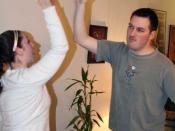Demonstrative Communication
�
�
Demonstrative Communication
There are several ways that communication can be described. Communication is the process of conveying, transmitting, and receiving, or sending and accepting messages. It has to do with the reciprocation of data, ideas, and messages, through speech, behavior, writing, and signals. Communication may be verbal or nonverbal. Nonverbal communications can be expressed through one's body posture, facial expressions, tone of voice, gestures, and eye contact; whereas verbal communication is expressed through oral communication or written.
This paper will focus on demonstrative communication; a form of communication that has to do with unwritten and nonverbal communications. This paper will review some of the many ways demonstrative communication can be ineffective and effective, negative or positive, mutually for sender and receiver. This paper will also show the ways in which demonstrative communication is necessary when listening and responding.
Demonstrative Communication may be Positive and Effective
Demonstrative communication takes account of unwritten and nonverbal communications, as was pointed out earlier.
This form of communication deals with transmitting, sending and accepting nonverbal messages (Nayba, 2010). It is frequently acted upon to draw attention to verbal communications, despite the fact that it can single handedly express messages by itself. Facial expressions are commonly used in nearly every nonverbal communication. As stated by Nayba (2010), it is likely that body language and facial expressions make up at least 50% of all nonverbal communications.
Demonstrative communication puts an emphasis on verbal communication. For instance, a person that has a firm handshake, is dressed well, and has a pleasant conduct may articulate the person's social an interview. An individual could reckon on this behavior to strengthen the verbal performance (Sutton, 2011). When a person meets someone, each individual may mutually sense the personality of the person like the friendliness of the person...


